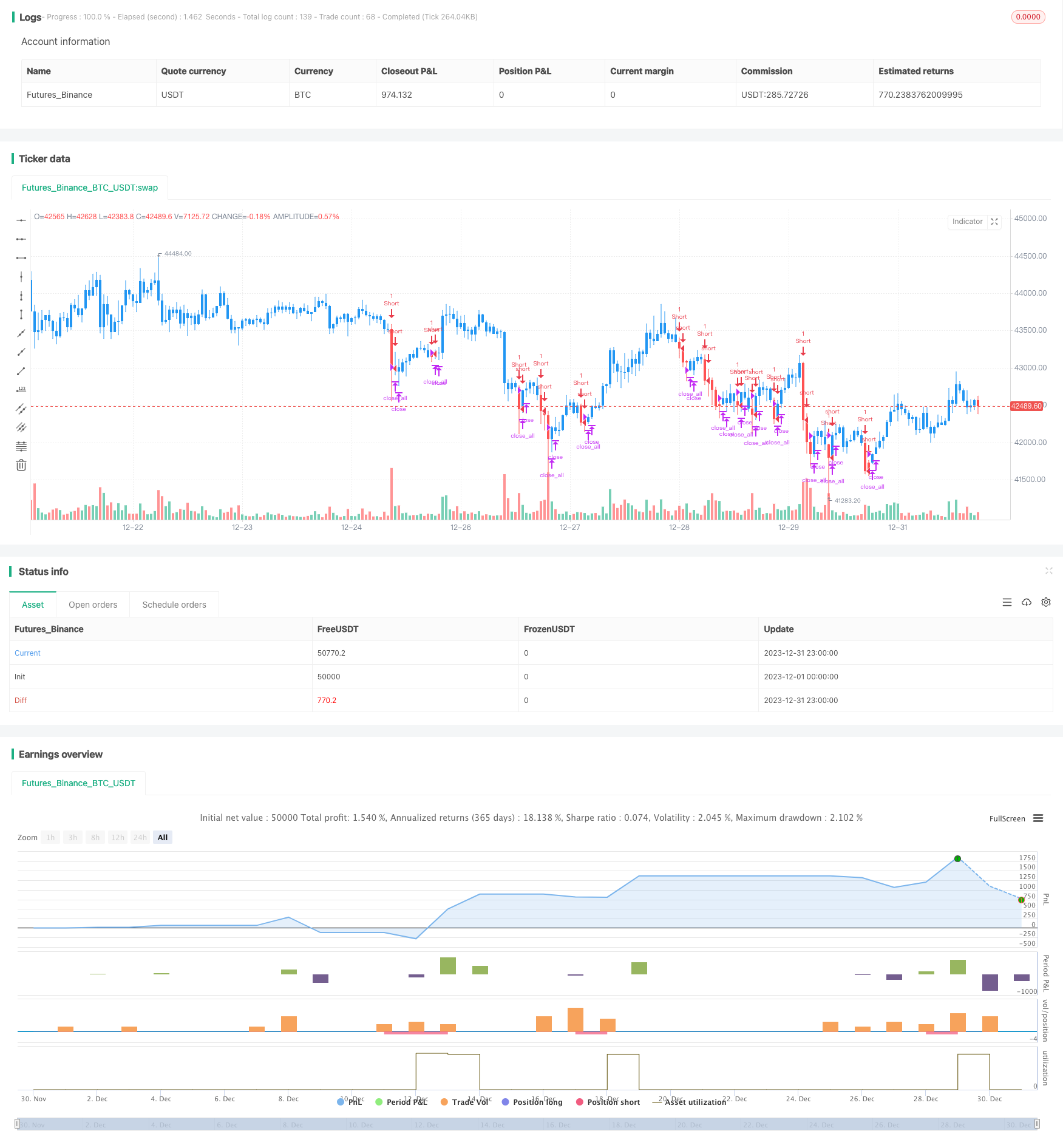
概述
坚果123反转与突破范围短线交易策略是一种组合策略, 它集成了反转策略和突破策略两个子策略的信号,从而产生更强劲的交易信号.
策略原理
该策略由两个子策略组成:
坚果123反转策略
它是根据Ulf Jensen的书中P183所介绍的系统改编的反转策略. 当收盘价连续2日高于前一日收盘价,且9日Stochastic慢线低于50时做多; 当收盘价连续2日低于前一日收盘价,且9日Stochastic快线高于50时做空.
突破范围短线策略
它是突破特定周期内最低价作为信号的短线策略. 当价格突破look_bak周期内的最低价时做空.
该组合策略综合考虑两个子策略的信号, 当两个子策略同时发出同向信号时, 产生该方向的交易信号; 当两个子策略发出相反信号时, 并不产生实际的交易信号.
优势分析
该策略结合反转策略和突破策略两个子策略的优点, 综合考虑更多因素, 可以过滤掉一些噪音交易, 提高交易胜率.
反转策略可以捕捉短期反转机会, 在涨跌调整过程中获利.
突破策略可以抓住突破后的短线走势.
组合考虑两个子策略的信号, 可以发出更有效的交易信号, 过滤噪音.
风险分析
该策略也存在以下风险:
反转不一定发生, 存在反转失败的风险.
突破也可能是假突破, 存在追高跌低的风险.
两个子策略都不能保证单独使用时就有效, 组合使用也可能失败.
针对上述风险, 可以通过优化参数,调整子策略的使用比例, 选择不同的标的进行套利等方法来降低风险.
优化方向
该策略还有进一步优化的空间:
优化两个子策略的参数, 使其更好地适应不同周期和不同标的.
增加其他类型的子策略, 如机器学习预测策略, 整合更多因素.
动态调整两个子策略的使用权重, 在不同市场环境下,让表现更好的子策略发挥更大作用.
进行组合套利,选择相关性不强又存在一定共性的不同标的进行交易.
总结
坚果123反转与突破范围短线交易策略通过集成反转策略和突破策略,进行了策略层面的组合,在一定程度上综合了两个子策略的优势,也存在可以进一步优化的空间. 它为我们提供了策略设计的新的思路,即在保留子策略独立性的基础上,进行策略层面的集成与组合,发掘更有效的交易机会.
/*backtest
start: 2023-12-01 00:00:00
end: 2023-12-31 23:59:59
period: 1h
basePeriod: 15m
exchanges: [{"eid":"Futures_Binance","currency":"BTC_USDT"}]
*/
//@version=4
////////////////////////////////////////////////////////////
// Copyright by HPotter v1.0 01/07/2019
// This is combo strategies for get a cumulative signal.
//
// First strategy
// This System was created from the Book "How I Tripled My Money In The
// Futures Market" by Ulf Jensen, Page 183. This is reverse type of strategies.
// The strategy buys at market, if close price is higher than the previous close
// during 2 days and the meaning of 9-days Stochastic Slow Oscillator is lower than 50.
// The strategy sells at market, if close price is lower than the previous close price
// during 2 days and the meaning of 9-days Stochastic Fast Oscillator is higher than 50.
//
// Second strategy
// Breakout Range Short Strategy
//
// WARNING:
// - For purpose educate only
// - This script to change bars colors.
////////////////////////////////////////////////////////////
Reversal123(Length, KSmoothing, DLength, Level) =>
vFast = sma(stoch(close, high, low, Length), KSmoothing)
vSlow = sma(vFast, DLength)
pos = 0.0
pos := iff(close[2] < close[1] and close > close[1] and vFast < vSlow and vFast > Level, 1,
iff(close[2] > close[1] and close < close[1] and vFast > vSlow and vFast < Level, -1, nz(pos[1], 0)))
pos
BreakoutRangeShort(look_bak) =>
pos = 0
xLowest = lowest(low, look_bak)
pos := iff(low < xLowest[1], -1, 0)
pos
strategy(title="Combo Backtest 123 Reversal & Breakout Range Short", shorttitle="Combo", overlay = true)
Length = input(14, minval=1)
KSmoothing = input(1, minval=1)
DLength = input(3, minval=1)
Level = input(50, minval=1)
//-------------------------
look_bak = input(4, minval=1, title="Look Bak")
reverse = input(false, title="Trade reverse")
posReversal123 = Reversal123(Length, KSmoothing, DLength, Level)
posBreakoutRangeShort = BreakoutRangeShort(look_bak)
pos = iff(posReversal123 == 1 and posBreakoutRangeShort == 1 , 1,
iff(posReversal123 == -1 and posBreakoutRangeShort == -1, -1, 0))
possig = iff(reverse and pos == 1, -1,
iff(reverse and pos == -1, 1, pos))
if (possig == 1)
strategy.entry("Long", strategy.long)
if (possig == -1)
strategy.entry("Short", strategy.short)
if (possig == 0)
strategy.close_all()
barcolor(possig == -1 ? color.red: possig == 1 ? color.green : color.blue )